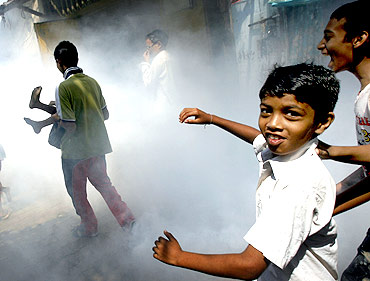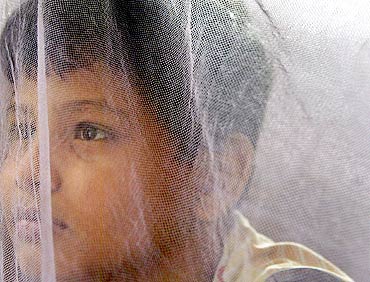 | « Back to article | Print this article |
India's malaria deaths 13 times more than WHO estimates
Malaria kills more than 200,000 people in India every year, nearly 13 times higher than a 'misleadingly low' World Health Organisation estimate, a new study has claimed, but the United Nations body disputed the finding.
The World Health Organisation, which estimates that about 15,000 people die of malaria in India each year, said the new study cannot be accepted without 'further validation.' The new study was published in the prestigious British medical journal 'The Lancet.'
Text: PTI
Click NEXT to read further..
'UN estimates misleadingly low'
"The upper limit is around 2,77,000 and the lower limit is nearly 1,25,000," the study said. Describing the WHO estimates as "misleadingly low" and "gross underestimation", the study pointed out that the UN agency takes into account only those deaths confirmed and recorded by hospitals and other healthcare facilities.
The WHO, however, expressed serious doubts about the number of malaria deaths identified by the Lancet research team. "The new study uses verbal autopsy method which is suitable only for diseases with distinctive symptoms and not for malaria, WHO's India representative Nata Menabde said in a statement in New Delhi.
"WHO welcomes independent studies for estimating malaria deaths provided the method used is appropriate. The limitations of verbal autopsy, and the implausibly high case incidence rates implied by the malaria mortality estimates, indicate that the (Lancet) findings cannot be accepted without further validation," he said.
Lancet report cannot be accepted without further validation: WHO
The use of verbal autopsy for malaria may result in many false positives, he added. In this method, deaths due to fever from any cause are likely to be misinterpreted as malaria in areas with high incidence, Menabde said.
In areas with low incidence, the symptoms are difficult to distinguish and would result in over-estimates of malaria deaths, he added. Authors of the Lancet study said their findings suggest that 'the low WHO estimate of malaria deaths in India (and only 100,000 adult malaria deaths per year worldwide) should be reconsidered.'
The Lancet study said that since many deaths occur at homes rather than in hospitals or clinics, the underlying cause of many malaria fatalities in India is likely to be misattributed.
It also said that the cases and deaths reported by the Indian government are concentrated mainly in a few states in east and northeast India -- the so-called high-malaria states such as Orissa, Chhattisgarh, Jharkhand, and the states in the far north-east of India.
'Indian malaria programme detects only 1,000 deaths'
"Because the Indian national malaria programme cures nearly all the cases it treats, it detects only about 1,000 malaria deaths each year, and misses most deaths caused by malaria," said the report, highlighting the estimating flaws.
The study deployed trained field workers who interviewed families or other respondents about each of 122,000 deaths during 2001-03 in 6,671 randomly selected areas across the country.
The field workers sent back reports on each case as well as answers to specific questions which were asked if the individual had died of a fever.
The data was then analysed separately by doctors, who gave their independent opinion of the underlying cause of death. A review board adjudicated in cases where there was a dispute.
'86 per cent deaths not in health-care facility'
Of the total number of deaths, 2,681 were found to be due to malaria. 90 per cent of these deaths had happened in rural areas and 86 per cent were not in health-care facility.
"Death rates attributed to malaria", it said, "correlated geographically with local malaria transmission rates derived independently from the Indian malaria control programme".
Extrapolated nationwide, it was found that malaria killed 205,000 deaths every year before the age of 70, comprising 55,000 in early childhood, 30,000 between the age of five and 14 and 120,000 at ages 15 to 69, the report said.
"If WHO estimates of malaria deaths in India or among adults worldwide are likely to be serious underestimates, this could substantially change disease control strategies, particularly in the rural parts of states with high malaria burden," they added.




